Ecotherapy with ADHD & Autism Spectrum
What is ecotherapy?
Ecotherapy is an umbrella term for a diverse range of nature-based therapeutic activities, such as taking therapy outdoors, walking therapy, mindfulness retreats, wilderness and adventure therapy, horticulture, gardening, forest bathing (shinrin-yoku), bushcrafting, herbalism, and animal-assisted therapy, to name a few. Although the contemporary advent of ecotherapy was coined in 1996 by Howard Clinebell in his book Ecotherapy: Healing Ourselves, Healing the Earth, healing in conjunction with the more-than-human (nature) world is rooted in Indigenous communities. Ecotherapy connects to the symbiotic relationship between humans and nature (Clinebell, 1996).
Ecotherapy is the application of ecopsychology, an interdisciplinary and transdisciplinary field rooted in the countercultural movement of the 1960s, which combines ideas from deep ecology, environmentalism, climate activism, and psychology. The term ecopsychology was coined by Theodore Roszak (1992), coming out of a body of work from theorists such as Paul Shepard, that argued that through industrialization and capitalism, our disconnection and non-reciprocal (take what we want) relationship with nature caused all sorts of issues from disease to depression, including the climate crisis.
Shifting experience…
Ecopsychologist Laura Sewall, PhD says of Stephen Kaplan’s Attention-Restoration Theory that “according to the body of research supporting attention-restoration theory (ART), natural scenes that are rich in fascinating stimuli invoke involuntary attention modestly or without effort…exposed to natural scenes, including views from windows and photographs, subjects perform better on a number of tests designed to measure the capacity to direct and sustain attention” (Kahn, Hasbach & Sewall, 2012, p. 272). Taking therapy into nature settings can allow for more relaxed, mindful, meaningful shifting of the focus of attention. Because there is a different orientation between client and therapist outside of the office setting, the pressure of being seen and experienced opens up to involve another partner—the more-than-human world. Abundant meaning-making around our sensory experiences of the world can come through magic, powerful synchronicities of plant and animal life entering the therapy space.
The relationship between Autism Spectrum Disorder (ASD) and Attention Deficit Hyperactivity Disorder (ADHD)
Both ASD and ADHD are neurodevelopmental (brain development), and have several symptoms in common. However, ADHD is not on the autism spectrum. Both ASD and ADHD can be co-occuring. Here is a comparison of the two conditions:
Source: https://www.healthline.com/health/adhd/autism-and-adhd#symptoms
Why ecotherapy for ASD and ADHD?
American author and journalist Richard Louv says that many children experience “nature-deficit disorder”, or that reduced time in outdoor settings and increased screen time can effect both physical and mental health (Louv, 2019). For clients with ASD and ADHD, research suggests that exposure to natural settings as part of therapy can assist with self-regulation, sensory processing difficulties, overstimulation, problem-solving, environmental desensitization, and decreasing symptoms of anxiety and depression (Ramshini, Hasanzadeh, Afroz & Razini, 2018).
Sitting across from a therapist in an office can feel overwhelming for someone experiencing ASD or ADHD. The orientation of therapist and client in this setting can trigger a variety of symptoms that may impede the therapy process. Inviting nature settings could be a beneficial ally. When assessing a client’s interest in ecotherapy, I usually ask the following:
What’s a way in which you connect with nature?
What are your favorite places to visit in nature?
How do you feel when you are in nature?
What natural places and being do you feel most connected with?
How do you show care for nature?
Taking therapy outdoors
Not every client will show the same affection for the outdoors. Some may even be averse. There is diverse spectrum of relationship with nature. That’s why it’s good to ask questions before making any decisions. These questions can be a powerful intervention in their own right. For clients who are curious, but not quite sure whether they want to take therapy outdoors, introducing writing, art, and photographs of nature into the therapeutic process may be a fantastic way to start. When you are ready to go outdoors, being explicit about what it means to move from the indoor container, including issues of confidentiality (what happens when we see someone we know?), safety (am I prepared in the event of injury?), accessibility (does my client have any physical limitations?), comfort (is the environment familiar to the client?), weather (what happens when the weather abruptly changes?), fear (does the client have any fears that could be triggered?), is key.
Citations:
Clinebell, H. (1996). Ecotherapy: Healing Ourselves, Healing the Earth. New York, NY: Routledge.
Kahn, P., Jr., Sewall, L., & Hasbach, P. (2012). Beauty and the Brain. In P. Kahn., Jr. & P. Hasbach (Eds.), Ecopsychology: Science, Totems, and the Technological Species. (pp. 241-264). Cambridge, MA: MIT.
Louv, R. (2019, Octoober 15). What is nature-deficit disorder? Retrieved April 28, 2022, from http://richardlouv.com/blog/what-is-nature-deficit-disorder
Ramshini, M., Hasanzadeh, S., Afroz, G., Razini, H. (2018). The Effect of Family-Centered Nature Therapy on Children With Autism Spectrum Disorder. University of Social Welfare and Rehabilitation Services Journal 19 (2), 150-159. http://rehabilitationj.uswr.ac.ir/article-1-2294-en.html


